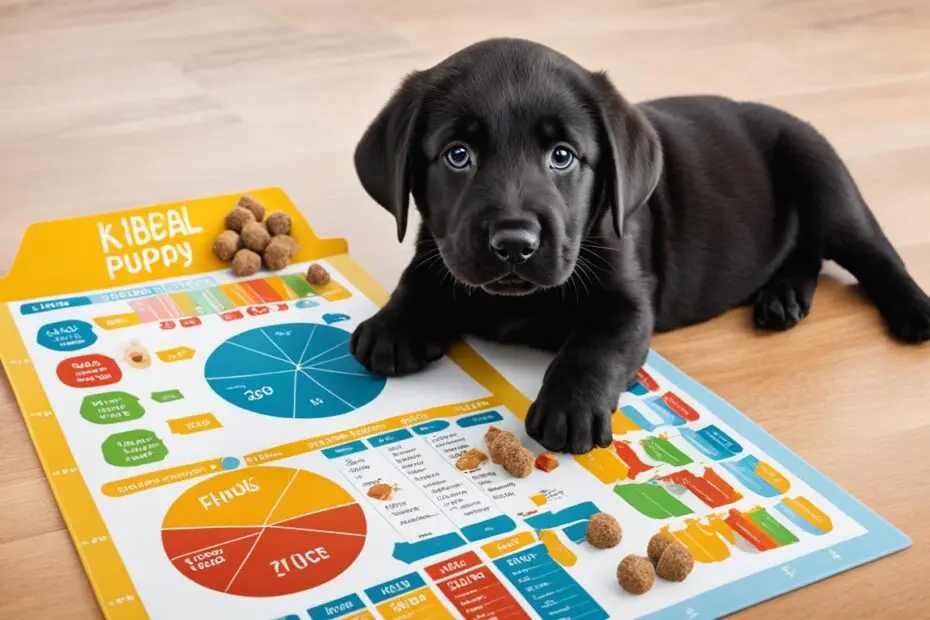The Labrador Retriever is America’s number one dog breed, known for being friendly, obedient, and affectionate. Feeding your labrador puppy the right nutrition is essential for their growth and overall health. In this comprehensive guide, we will answer common questions about labrador puppy feeding, such as how much to feed, the types of puppy food available, the importance of high-quality food, and the specific nutrients lab puppies need at different stages of their growth. We will also provide a labrador puppy feeding chart to help you ensure your puppy receives the proper amount of food at each stage of their development.
Key Takeaways:
- A labrador puppy’s diet plays a crucial role in their growth and overall health.
- Feeding your labrador puppy the right amount of food is important to prevent overfeeding or underfeeding.
- There are various types of puppy food available, including kibble, wet food, raw food, and home-cooked food. Choose one that suits your puppy’s needs.
- Feeding your labrador puppy high-quality food ensures they get the necessary nutrients for optimal growth and development.
- Lab puppies require specific nutrients such as protein, calcium, phosphorus, omega-3 fatty acids, carbohydrates, vitamins, and minerals.
How Much Should A Lab Puppy Eat?
Feeding your labrador puppy the right amount of food is crucial for their overall health and development. The Labrador Retriever is a medium to large breed with a hearty appetite, so it’s important to establish a feeding routine and portion sizes. Our labrador puppy feeding chart provides a guideline for how much food to give your puppy at each week of their initial life stage. However, it’s important to remember that all puppies are different, so you may need to adjust the portion sizes based on your puppy’s individual needs and growth rate.
Establishing a Feeding Routine
Creating a consistent feeding routine for your labrador puppy will help regulate their appetite and digestion. Ideally, you should aim to feed your puppy at the same times each day, providing a structured meal plan. This routine can also aid in potty training, as puppies tend to eliminate shortly after eating.
Determining Portion Sizes
Portion sizes for labrador puppies can vary depending on factors such as age, weight, activity level, and metabolism. It’s important not to overfeed your puppy, as excess weight can lead to health issues. The labrador puppy feeding chart below provides a general guideline for the amount of food to give your puppy based on their age:
| Age (Weeks) | Amount of Food (Cups per Day) |
|---|---|
| 6-8 | 1-1.5 |
| 8-12 | 1.5-2 |
| 12-16 | 2-2.5 |
| 16-20 | 2.5-3 |
It’s important to monitor your labrador puppy’s weight and body condition score regularly. If your puppy is gaining too much weight or becoming overweight, you may need to adjust the portion sizes accordingly. On the other hand, if your puppy is not gaining enough weight or appears to be underweight, you may need to increase the amount of food provided.
Remember, the labrador puppy feeding chart is just a starting point, and it’s essential to consider your puppy’s individual needs. It’s always best to consult with your veterinarian for personalized feeding recommendations and to address any concerns or questions about your labrador puppy’s diet.

In conclusion, there are various types of puppy food available for your Labrador puppy. Whether you choose kibble, wet food, raw food, or home-cooked meals, it’s crucial to prioritize their nutritional needs. Remember to consider convenience, nutritional value, and your puppy’s dietary requirements when making a decision. Consult with a veterinarian to ensure you are providing the best food for your Labrador puppy’s health and growth.
The Importance Of High-Quality Food
Feeding your labrador puppy high-quality food is essential for their overall health and well-being. High-quality food is formulated to provide the necessary nutrients that puppies need for optimal growth and development. It should contain a balance of protein, carbohydrates, vitamins, and minerals. Additionally, high-quality food is more digestible and less likely to cause digestive issues or allergies.
Labrador puppies have specific nutritional needs, and providing them with high-quality food ensures that those needs are met. The right diet plays a crucial role in supporting their bone development, muscle growth, and overall health.
When it comes to choosing the best food for your labrador puppy, look for a reputable brand that specializes in puppy nutrition. Avoid generic or low-quality brands as they may not provide the necessary nutrients or may contain fillers that offer little nutritional value.
Here are some key benefits of feeding your labrador puppy high-quality food:
- Proper Growth and Development: High-quality food is designed to meet the specific nutritional requirements of growing puppies, ensuring they receive the right balance of nutrients.
- Strong Immune System: The vitamins and minerals in high-quality food help support a healthy immune system, protecting your labrador puppy from illnesses.
- Digestive Health: High-quality food is easily digestible, reducing the risk of digestive problems such as upset stomachs or diarrhea. This is particularly important for labrador puppies, as they can be prone to sensitive stomachs.
- Coat and Skin Health: Good nutrition promotes a shiny coat and healthy skin. High-quality food contains essential fatty acids, such as omega-3 and omega-6, which support coat and skin health.
- Maintaining a Healthy Weight: High-quality food helps your labrador puppy maintain an appropriate weight, reducing the risk of obesity and related health issues.
When selecting high-quality puppy food, look for the Association of American Feed Control Officials (AAFCO) statement on the packaging. This statement ensures that the food meets the minimum nutritional requirements established by the AAFCO.
Remember, every labrador puppy is different, so it’s important to consult with your veterinarian for specific feeding recommendations based on your puppy’s age, weight, and overall health.
Choosing the Best Food for Your Labrador Puppy
When choosing the best food for your labrador puppy, consider the following factors:
- Nutritional Content: Check the label for high-quality protein sources (such as chicken or lamb), whole grains, fruits, and vegetables.
- Life Stage-Specific Formulas: Look for puppy-specific formulas that cater to the nutritional needs of growing labrador puppies.
- Read Reviews: Research and read reviews to get insights from other labrador puppy owners who have tried the food.
- Veterinarian Recommendations: Consult with your veterinarian for specific recommendations based on your labrador puppy’s individual needs.

| Nutrient | Sources |
|---|---|
| Protein | Chicken, beef, fish |
| Calcium and Phosphorus | Puppy food formulated for large breeds |
| Omega-3 Fatty Acids | Fish oil, flaxseed |
| Carbohydrates | Whole grains like brown rice and oats |
| Vitamins and Minerals | Fruits, vegetables, and fortified puppy food |
How Much Do Lab Puppies Grow Each Week?
Labrador puppies experience rapid growth during their first months of life. On average, lab puppies can gain 2-4 pounds per week during their early growth stages. However, it’s important to note that growth rates can vary among individuals, so it’s crucial to monitor your puppy’s growth and adjust their food portions accordingly.
To ensure your labrador puppy is receiving the right amount of food at each stage of their development, it’s useful to refer to a labrador puppy feeding chart. This chart provides a week-by-week guideline for the amount of food your lab puppy should be eating. However, it’s essential to remember that these are general guidelines, and consulting with your veterinarian for personalized feeding recommendations based on your puppy’s growth rate and overall health is highly recommended.

The Importance of Monitoring Growth
Monitoring your labrador puppy’s growth is crucial to ensure they are developing at a healthy rate. It allows you to make necessary adjustments to their food portions to prevent overfeeding or underfeeding, which can impact their overall health and well-being.
Additionally, monitoring their growth can help identify any potential issues or abnormalities early on, allowing you to address them promptly with the guidance of your veterinarian.
“Properly monitoring a labrador puppy’s growth helps ensure they develop into a healthy and happy adult dog.” – Dr. Jane Foster, Veterinarian
Labrador Puppy Feeding Chart
Here is a sample labrador puppy feeding chart that provides a general guideline for the amount of food to give your lab puppy at different weeks of their growth:
| Weeks | Amount of Food (cups) |
|---|---|
| 6-8 | 1-2 |
| 8-12 | 2-3 |
| 12-16 | 3-4 |
| 16-24 | 4-5 |
Remember, this is just a guideline, and individual puppies may have different caloric requirements based on their size, activity level, and metabolism. It’s essential to monitor their growth, body condition, and consult with your veterinarian to ensure your labrador puppy’s dietary needs are met.
Next, we’ll discuss how to keep your labrador puppy at a healthy weight and the importance of regular exercise in supporting their overall health.
Keeping Your Lab At The Right Weight
Maintaining a healthy weight is crucial for labrador puppies to prevent potential health issues. Labradors are known for their love of food and are prone to obesity, which can lead to joint problems and other health complications. To ensure your lab stays at the right weight, it’s important to follow these labrador puppy feeding tips:
- Measure Portions: Feed your labrador puppy the appropriate amount of food according to their age, weight, and activity level. Avoid free-feeding or leaving food out all day, as it can lead to overeating. Consistency and portion control are key.
- Choose High-Quality Food: Opt for a high-quality puppy food that is specifically formulated for labrador puppies. Look for a balanced diet that contains lean protein, whole grains, and essential nutrients. Read the labels and choose wisely.
- Avoid Table Scraps: Resist the temptation to feed your labrador puppy table scraps or human food. These foods can be high in calories and may not provide the necessary nutrition. Stick to their designated puppy food. Keep the treats to a minimum.
- Establish a Feeding Schedule: Create a consistent feeding schedule for your labrador puppy. Typically, feeding them three times a day until they are about six months old is recommended. Gradually transition to two meals a day as they mature. Structure and routine are important.
In addition to proper feeding, regular exercise is essential to maintain your labrador puppy’s weight and overall health. Here are some labrador puppy weight control tips:
- Regular Exercise: Engage your labrador puppy in daily exercise, such as walks, playtime, or interactive games. Aim for at least 30 minutes to one hour of exercise each day, depending on their age and energy level. A tired lab is a happy lab.
- Monitor Body Condition: Keep an eye on your labrador puppy’s body condition score. You should be able to feel their ribs without seeing them. If they are difficult to feel or you notice excess fat around their ribs and waist, it’s time to adjust their food portions. Regularly assess their physique.
By following these labrador puppy feeding tips and promoting regular exercise, you can help your labrador puppy maintain a healthy weight. Remember to consult with your veterinarian for personalized feeding recommendations and to address any concerns or questions about your labrador puppy’s weight control.
| Labrador Puppy Weight Control Tips |
|---|
| Measure portions to avoid overfeeding |
| Choose high-quality puppy food |
| Avoid giving table scraps |
| Establish a consistent feeding schedule |
| Engage in regular exercise |
| Monitor body condition score |
Conclusion
Feeding your Labrador puppy a balanced and nutritious diet is crucial for their overall health and development. By following a Labrador puppy feeding chart and providing high-quality food, you can ensure that your puppy receives the proper nutrition they need at each stage of their growth.
Monitoring your puppy’s weight and adjusting their portions as needed is essential for maintaining a healthy weight. Obesity can lead to various health issues, so it’s important to feed them the appropriate amount of food and incorporate regular exercise into their routine.
Remember to consult with your veterinarian for personalized feeding recommendations and to address any concerns or questions about your Labrador puppy’s diet. Regular veterinary check-ups are important for their overall well-being. With proper nutrition, exercise, and veterinary care, you can help your Labrador puppy thrive and become a happy and healthy adult dog.
FAQ
What is a labrador puppy feeding chart?
A labrador puppy feeding chart is a guideline that provides information on how much food to give your labrador puppy at each week of their initial life stage. It helps ensure your puppy receives the proper amount of food for their growth and development.
How much should I feed my labrador puppy?
The amount of food to feed your labrador puppy depends on their age, size, and activity level. It is best to consult with your veterinarian or refer to a labrador puppy feeding chart for guidance on portion sizes.
What types of food are suitable for labrador puppies?
There are several types of food available for labrador puppies, including kibble (dry food), wet food, raw food, and home-cooked food. Each type has its benefits and drawbacks, so it’s important to consider factors such as convenience and nutritional value when making your choice.
Why is high-quality food important for labrador puppies?
Feeding your labrador puppy high-quality food is essential for their overall health and well-being. High-quality food provides the necessary nutrients they need for optimal growth and development and is less likely to cause digestive issues or allergies.
What nutrients do labrador puppies need?
Lab puppies need a diet that is rich in protein for muscle development, calcium and phosphorus for bone growth, and omega-3 fatty acids for brain and eye development. They also need a balance of carbohydrates, vitamins, and minerals for their overall health.
How much do lab puppies grow each week?
On average, labrador puppies can gain 2-4 pounds per week during their early growth stages. However, growth rates can vary among individuals, so it’s important to monitor your puppy’s growth and adjust their food portions accordingly.
How can I keep my labrador puppy at a healthy weight?
To keep your labrador puppy at a healthy weight, it’s important to feed them the appropriate amount of food and provide regular exercise. Monitoring their body condition score and adjusting their portions as needed can help prevent excessive weight gain.
What is the importance of regular exercise for labrador puppies?
Regular exercise is important for labrador puppies to support their overall health and well-being. It helps maintain a healthy weight, promotes muscle development, and provides mental stimulation. Consult with your veterinarian for advice on suitable exercise activities for your labrador puppy.

